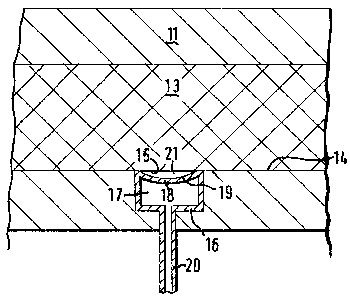Une partie des informations de ce site Web a été fournie par des sources externes. Le gouvernement du Canada n'assume aucune responsabilité concernant la précision, l'actualité ou la fiabilité des informations fournies par les sources externes. Les utilisateurs qui désirent employer cette information devraient consulter directement la source des informations. Le contenu fourni par les sources externes n'est pas assujetti aux exigences sur les langues officielles, la protection des renseignements personnels et l'accessibilité.
L'apparition de différences dans le texte et l'image des Revendications et de l'Abrégé dépend du moment auquel le document est publié. Les textes des Revendications et de l'Abrégé sont affichés :
| (12) Brevet: | (11) CA 1315940 |
|---|---|
| (21) Numéro de la demande: | 1315940 |
| (54) Titre français: | PROCEDE DE REDUCTION DU TEMPS DE MOULAGE |
| (54) Titre anglais: | PROCESS REDUCING OF MOULD CYCLE TIME |
| Statut: | Périmé et au-delà du délai pour l’annulation |
| (51) Classification internationale des brevets (CIB): |
|
|---|---|
| (72) Inventeurs : |
|
| (73) Titulaires : |
|
| (71) Demandeurs : |
|
| (74) Agent: | SWABEY OGILVY RENAULT |
| (74) Co-agent: | |
| (45) Délivré: | 1993-04-13 |
| (22) Date de dépôt: | 1988-12-08 |
| Licence disponible: | S.O. |
| Cédé au domaine public: | S.O. |
| (25) Langue des documents déposés: | Anglais |
| Traité de coopération en matière de brevets (PCT): | Non |
|---|
| (30) Données de priorité de la demande: | ||||||
|---|---|---|---|---|---|---|
|
T 8223
A B S T R A C T
PROCESS REDUCING OF MOULD CYCLE TIME
A method is disclosed for the reduction of mould cycle time.
A deflatable member is positioned flush with the surface of a mould
in an opening defined downwardly therein. Prior to flow of a resin
or other hardenable liquid within the mould, the deflatable member
is deflated so as to define a resin flow channel across selected
portions of the mould surface. Prior to hardening of the
hardenable liquid within the mould, the deflatable member is
inflated so as to become flush with the surface of the mould so as
to yield an article of manufacture having a relatively planar
surface.
T14/T8223
Note : Les revendications sont présentées dans la langue officielle dans laquelle elles ont été soumises.
Note : Les descriptions sont présentées dans la langue officielle dans laquelle elles ont été soumises.

2024-08-01 : Dans le cadre de la transition vers les Brevets de nouvelle génération (BNG), la base de données sur les brevets canadiens (BDBC) contient désormais un Historique d'événement plus détaillé, qui reproduit le Journal des événements de notre nouvelle solution interne.
Veuillez noter que les événements débutant par « Inactive : » se réfèrent à des événements qui ne sont plus utilisés dans notre nouvelle solution interne.
Pour une meilleure compréhension de l'état de la demande ou brevet qui figure sur cette page, la rubrique Mise en garde , et les descriptions de Brevet , Historique d'événement , Taxes périodiques et Historique des paiements devraient être consultées.
| Description | Date |
|---|---|
| Inactive : CIB de MCD | 2006-03-11 |
| Inactive : CIB de MCD | 2006-03-11 |
| Inactive : CIB de MCD | 2006-03-11 |
| Le délai pour l'annulation est expiré | 1998-04-14 |
| Lettre envoyée | 1997-04-14 |
| Accordé par délivrance | 1993-04-13 |
Il n'y a pas d'historique d'abandonnement
Les titulaires actuels et antérieures au dossier sont affichés en ordre alphabétique.
| Titulaires actuels au dossier |
|---|
| SHELL INTERNATIONALE RESEARCH MAATSCHAPPIJ B.V. |
| Titulaires antérieures au dossier |
|---|
| JOSEPH NORMAN EPEL |